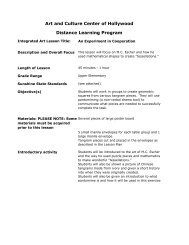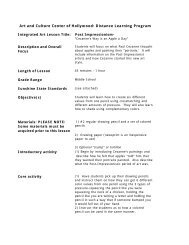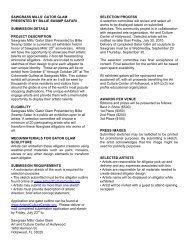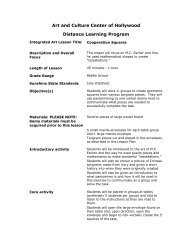Lesson plan [pdf] - Art and Culture Center of Hollywood
Lesson plan [pdf] - Art and Culture Center of Hollywood
Lesson plan [pdf] - Art and Culture Center of Hollywood
You also want an ePaper? Increase the reach of your titles
YUMPU automatically turns print PDFs into web optimized ePapers that Google loves.
<strong>Art</strong> <strong>and</strong> <strong>Culture</strong> <strong>Center</strong> <strong>of</strong> <strong>Hollywood</strong><br />
Distance Learning<br />
Integrated <strong>Art</strong> <strong>Lesson</strong> Title:<br />
Description <strong>and</strong> Overall Focus:<br />
Length <strong>of</strong> <strong>Lesson</strong><br />
Grade Range<br />
Sunshine State St<strong>and</strong>ards<br />
<strong>and</strong> National <strong>Art</strong> St<strong>and</strong>ards<br />
Objective(s)<br />
Materials: PLEASE NOTE: Some<br />
materials must be acquired<br />
prior to this lesson<br />
<strong>Art</strong> That Pops<br />
This project will allow students to learn how to create visual<br />
distortions using simple geometric shapes to make their<br />
drawings “pop.”<br />
45 minutes – 1 hour<br />
Lower Elementary<br />
(see below)<br />
Students will learn about the art <strong>of</strong> Victor Vasarely <strong>and</strong> the<br />
exhibit <strong>of</strong> Doug Crocco. They then will use math based<br />
geometric shapes to create black <strong>and</strong> white visual art<br />
projects that look like they are moving in <strong>and</strong> out.<br />
9” X 12” sheet <strong>of</strong> white construction paper<br />
Black crayon, felt pen or colored pencil.<br />
Drawing pencil <strong>and</strong> eraser<br />
Ruler<br />
Introductory activity<br />
Students will begin by learning about the art <strong>of</strong> Victor Vasarely<br />
<strong>and</strong> the Op art movement. They will also be shown some<br />
examples <strong>of</strong> the work <strong>of</strong> Doug Crocco who has an exhibit at<br />
the <strong>Art</strong> <strong>and</strong> <strong>Culture</strong> <strong>Center</strong>.<br />
They will also learn about the ways in which the eye anatomy<br />
can be fooled through the placement <strong>of</strong> objects on the page<br />
by an artist.<br />
Core activity<br />
Closure activity<br />
Students will begin by drawing vertical <strong>and</strong> horizontal lines in a<br />
specific manner to help develop an optical illusion. These<br />
mathematical rectangular forms <strong>and</strong> lines will then be filled in<br />
with a black crayon, felt pen or colored pencil in a specific<br />
manner to create a visual optical illusion.<br />
Students will complete their creations making sure that the<br />
black rectangles are fully filled in with an equally dark value<br />
until the whole project is uniform.<br />
Several students will then share their completed pictures with<br />
the rest <strong>of</strong> their viewing classmates.<br />
Assessment<br />
Students will have learned about the history <strong>and</strong> creations <strong>of</strong><br />
the Op art period. They will also have learned about Victor<br />
Vasarely <strong>and</strong> the work <strong>of</strong> Doug Crocco. The areas <strong>of</strong> math<br />
<strong>and</strong> science will also be studied during this lesson.
Teacher follow-up idea<br />
The teacher can use the books <strong>and</strong> websites below to present<br />
more <strong>of</strong> the information surrounding this fascinating art form.<br />
Student follow-up idea<br />
Cooking <strong>Lesson</strong><br />
Book/Web references<br />
Students can continue to make additional optical illusions<br />
using other geometric shapes (such as circles, ovals, etc.).<br />
Checkerboard Cake<br />
Op <strong>Art</strong> Coloring book by Jean Larcher<br />
Victor Vasarely by Magdalena Holzhey<br />
www.vasarely.com<br />
www.dougcrocco.com<br />
<strong>Art</strong> <strong>and</strong> <strong>Culture</strong> <strong>Center</strong> <strong>of</strong> <strong>Hollywood</strong><br />
www.art<strong>and</strong>culturecenter.org<br />
<strong>Lesson</strong> <strong>plan</strong> prepared by Sherie Tengbergen, artist <strong>and</strong> educator
ART<br />
BY<br />
DOUG CROCCO
VICTORY VASARELY
SUNSHINE STATE STANDARDS - ART THAT POPS –Lower Elementary Pre K -<br />
<strong>Art</strong>s: Dance<br />
*Skills <strong>and</strong> Techniques (DA.A.1) <strong>and</strong> (DA.A.2)<br />
*Creation <strong>and</strong> Communication (DA.B.1)<br />
*Cultural <strong>and</strong> Historical Connections (DA.C.1)<br />
*Aesthetic <strong>and</strong> Critical Analysis (DA.D.1)<br />
*Applications to Life (DA.E.1)<br />
<strong>Art</strong>s: Music<br />
*Skills <strong>and</strong> Techniques (MUA.1), (MUA.2) <strong>and</strong> (MUA.3)<br />
*Creation <strong>and</strong> Communication (MUB.1) <strong>and</strong> (MUB.2)<br />
*Cultural <strong>and</strong> Historical Connections (MUC.1)<br />
*Aesthetic <strong>and</strong> Critical Analysis (MUD.1) <strong>and</strong> (MUD.2)<br />
*Applications to Life (MUE.1) <strong>and</strong> (MUE.2)<br />
<strong>Art</strong>s: Theatre<br />
*Skills <strong>and</strong> Techniques (TH.A.1), (TH.A.2) <strong>and</strong> (TH.A.3)<br />
*Creation <strong>and</strong> Communication (TH.B.1)<br />
*Cultural <strong>and</strong> Historical Connections (TH.C.1)<br />
*Aesthetic <strong>and</strong> Critical Analysis (TH.D.1)<br />
*Applications to Life (TH.E.1)<br />
<strong>Art</strong>s: Visual <strong>Art</strong>s<br />
*Skills <strong>and</strong> Techniques (VA.A.1)<br />
*Creation <strong>and</strong> Communication (VA.B.1)<br />
*Cultural <strong>and</strong> Historical Connections (VA.C.1)<br />
*Aesthetic <strong>and</strong> Critical Analysis (VA.D.1)<br />
*Application to Life (VA.E.1)<br />
Language <strong>Art</strong>s<br />
*Reading Process (LA.1.1), (LA.1.2), ( LA.1.3), (LA.1.4), (LA.1.6) <strong>and</strong> (LA.1.7)<br />
*Literary Analysis (LA.2.1) <strong>and</strong> (LA.2.2.)<br />
*Writing Process (LA.3.1), (LA.3.2), (LA3.3.), (LA3.4) <strong>and</strong> (LA3.5)<br />
*Writing Applications (LA4.1), (LA4.2) <strong>and</strong> (LA.4.3)<br />
*Communication (LA.5.1) <strong>and</strong> (LA.5.2)<br />
*Information <strong>and</strong> Media Literacy (LA.6.1), (LA.6.2), (LA.6.3) <strong>and</strong> (LA.6.4)<br />
Mathematics<br />
*Number Sense, Concepts, & Operations (MA.A.1), (MA.A.2), (MA.A.3), (MA.A.4) <strong>and</strong> (MA.A.5.)<br />
*Measurement (MA.B.1), (MA.B.2), (MA.B.3) <strong>and</strong> (MA.B.4)<br />
*Geometry <strong>and</strong> Spatial Sense (MA.C.1), (MA.C.2) <strong>and</strong> (MA.C.3)<br />
*Algebraic Thinking (MA.D.1) <strong>and</strong> MA.D.2)<br />
*Data Analysis <strong>and</strong> Probability (MA.E.1), (MA.E.2) <strong>and</strong> (MA.E.3)<br />
Science<br />
*The Nature <strong>of</strong> Matter (SC.A.1) <strong>and</strong> (SC.A.2)<br />
*Energy (SC.B.1) <strong>and</strong> (SC.B.2)<br />
*Force <strong>and</strong> Motion (SC.C.1) <strong>and</strong> (SC.C.2)<br />
*Processes that Shape the Earth (SC.D.1) <strong>and</strong> (SC.D.2)<br />
*Earth <strong>and</strong> Science (SC.E.1) <strong>and</strong> (SC.E.2)<br />
*Processes <strong>of</strong> Life (SC.F.1) <strong>and</strong> (SC.F.2)<br />
*How Living Things Interact With Their Environment (SC.G.1) <strong>and</strong> (SC.G.2)<br />
*The Nature <strong>of</strong> Science (SC.H.1), (SC.H.2) <strong>and</strong> (SC.H.3)<br />
Social Studies<br />
*Time, Continuity <strong>and</strong> Change (History) (SS.A.1), (SS.A.2), (SS.A.3), (SS.A.4) <strong>and</strong> (SS.A.5)<br />
*People, Places <strong>and</strong> Environments (Geography) (SS.B.1) <strong>and</strong> (SS.B.2)<br />
*Government <strong>and</strong> the Citizen (Civics <strong>and</strong> Government) (SS.C.1) <strong>and</strong> (SS.C.2)<br />
*Economics (SS.D.1) <strong>and</strong> (SS.D.2)<br />
Foreign Language<br />
*Communication (FL.A.1) <strong>and</strong> (FL.A.2)<br />
*<strong>Culture</strong> (FL.B.1)<br />
*Connections (FL.C.1) <strong>and</strong> (FL.C.2)<br />
*Comparisons (FL.D.1) <strong>and</strong> (FL.D.2)<br />
*Experiences (FL.E.1)<br />
Health (No st<strong>and</strong>ards adopted)<br />
Physical Education<br />
2<br />
x<br />
x<br />
x<br />
x<br />
x<br />
x<br />
x<br />
x<br />
x<br />
x<br />
x<br />
x<br />
x<br />
x<br />
K<br />
3-5<br />
MS<br />
6-8<br />
HS<br />
9-12
*Physical Education Literacy (PE.A.1), (PE.A.2), (PE.A.3)<br />
*Responsible Physical Activity Behaviors (PE.B.1) <strong>and</strong> (PE.B.2)<br />
*Advocate <strong>and</strong> Promote Physically Active Lifestyles (PE.C.1) <strong>and</strong> (PE.C.2)<br />
NATIONAL ART STANDARDS MET:<br />
X<br />
X<br />
x<br />
x<br />
x<br />
x<br />
NA-VA.K-4.1 UNDERSTANDING AND APPLYING MEDIA, TECHNIQUES, AND PROCESSES.<br />
NA-VA.K-4.2 USING KNOWLEDGE OF STRUCTURES AND FUNCTIONS.<br />
NA-VA.K-4.3 CHOOSING AND EVALUATING A RANGE OF SUBJECT MATTER, SYMBOLS, AND IDEAS.<br />
NA-VA.K-4.4 UNDERSTANDING THE VISUAL ARTS IN RELATION TO HISTORY AND CULTURES.<br />
NA-VA.K-4.5 REFLECTING UPON AND ASSESSING THE CHARACTERISTICS AND MERITS OF THEIR WORK AND THE<br />
WORK OF OTHERS<br />
NA-VA.K-4.6 MAKING CONNECTIONS BETWEEN VISUAL ARTS AND OTHER DISCIPLINES.
Checkerboard Cake<br />
Can’t pick your favorite? Bake a Checkerboard Cake<br />
<strong>and</strong> you can put two flavors in one cake! Our<br />
checkerboard Cake Pan Set, with three cake pans <strong>and</strong><br />
a reusable ringed insert, makes it easy to get perfect<br />
results every time.<br />
Tools:<br />
• Checkerboard Cake Pan Set<br />
Ingredients:<br />
• 2 sticks butter or margarine s<strong>of</strong>tened<br />
• 2 2/3 cups granulated sugar<br />
• 3 eggs<br />
• 2 teaspoons vanilla extract<br />
• 4 cups all-purpose flour<br />
• 1 tablespoon baking powder<br />
• 1 teaspoon salt<br />
• 2 cups milk<br />
• 4 ounces( 4 squares) semi-sweet chocolate melted<br />
• Chocolate Buttercream Icing<br />
Makes: Cake serves 20.<br />
INSTRUCTIONS: (DO NOT PUT DIVIDING RING IN OVEN)<br />
Preheat oven to 350°F. Spray pans with vegetable pan spray. In large bowl, cream butter <strong>and</strong> sugar with electric mixer until<br />
light <strong>and</strong> fluffy. Add eggs, one at a time, <strong>and</strong> vanilla; mix well. Combine flour, baking powder <strong>and</strong> salt. Add to butter mixture<br />
alternately with milk; mix well after each addition. Continue beating 1 minute. Divide batter in half. Stir melted chocolate<br />
into half the batter; mix well.<br />
Place Batter Dividing Ring into one prepared pan. Follow instructions in pan set for filling sections shown below (for<br />
convenient filling, place batter in disposable decorating bag) <strong>and</strong> remove ring. Follow filling instructions for 2nd <strong>and</strong> 3rd pan.<br />
Bake 30-35 minutes or until toothpick inserted in center comes out clean. Cool in pan 10 minutes. Remove from pan <strong>and</strong> cool<br />
completely.<br />
Assemble cake. Position layer with chocolate cake on outside onto serving plate; spread top with chocolate icing. Position<br />
layer with yellow cake on outside on top <strong>of</strong> 1st layer; spread top with chocolate icing. Position final layer; ice entire cake<br />
with chocolate icing.<br />
Note: Other colored batters may be substituted for vanilla <strong>and</strong> chocolate. Pan set instructions for filling sections:<br />
Place Batter Dividing Ring in the first prepared 9 x 11/2 in. pan. Pour darker colored batter in outer <strong>and</strong> center sections <strong>and</strong><br />
lighter colored batter in the middle section. Fill sections halfway.<br />
Remove ring from pan by carefully lifting straight up on h<strong>and</strong>les. Rinse <strong>and</strong> completely dry ring.<br />
Place ring in 2nd prepared pan <strong>and</strong> repeat steps 1 <strong>and</strong> 2. These will be the top <strong>and</strong> bottom layers <strong>of</strong> your checkerboard cake.<br />
Place clean <strong>and</strong> dry ring in 3rd prepared pan. Pour lighter colored batter in outer <strong>and</strong> center sections <strong>and</strong> darker colored batter<br />
in the middle section. Fill sections halfway. This will be the middle layer <strong>of</strong> your checkerboard cake. Remove ring from<br />
pan as before. Bake <strong>and</strong> cool cakes following recipe directions. Remove <strong>and</strong> stack cakes.


![Lesson plan [pdf] - Art and Culture Center of Hollywood](https://img.yumpu.com/25290114/1/500x640/lesson-plan-pdf-art-and-culture-center-of-hollywood.jpg)


![Lesson plan [pdf] - Art and Culture Center of Hollywood](https://img.yumpu.com/25290132/1/190x245/lesson-plan-pdf-art-and-culture-center-of-hollywood.jpg?quality=85)




![Lesson plan [pdf] - Art and Culture Center of Hollywood](https://img.yumpu.com/25290088/1/190x245/lesson-plan-pdf-art-and-culture-center-of-hollywood.jpg?quality=85)
![Lesson plan [pdf] - Art and Culture Center of Hollywood](https://img.yumpu.com/25290085/1/190x245/lesson-plan-pdf-art-and-culture-center-of-hollywood.jpg?quality=85)
![Lesson plan [pdf] - Art and Culture Center of Hollywood](https://img.yumpu.com/25290081/1/190x245/lesson-plan-pdf-art-and-culture-center-of-hollywood.jpg?quality=85)
![Lesson plan [pdf] - Art and Culture Center of Hollywood](https://img.yumpu.com/25290082/1/190x245/lesson-plan-pdf-art-and-culture-center-of-hollywood.jpg?quality=85)
![Lesson plan [pdf] - Art and Culture Center of Hollywood](https://img.yumpu.com/25290077/1/190x245/lesson-plan-pdf-art-and-culture-center-of-hollywood.jpg?quality=85)
![Lesson plan [pdf] - Art and Culture Center of Hollywood](https://img.yumpu.com/25290073/1/190x245/lesson-plan-pdf-art-and-culture-center-of-hollywood.jpg?quality=85)